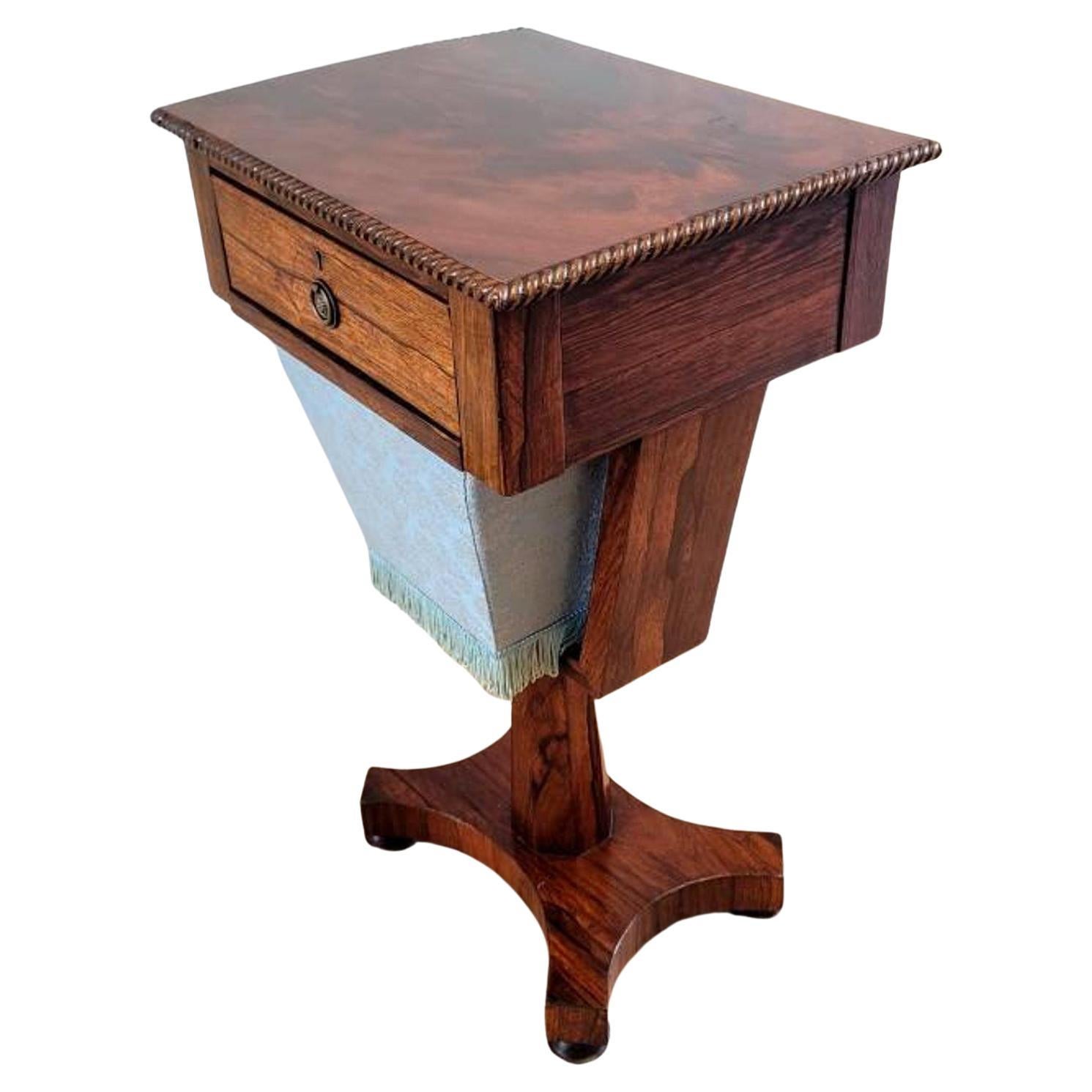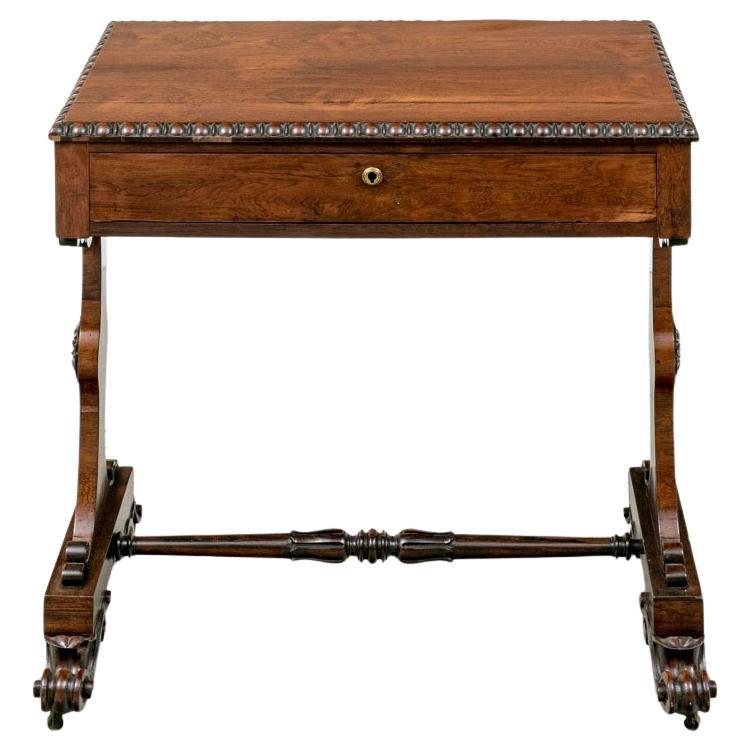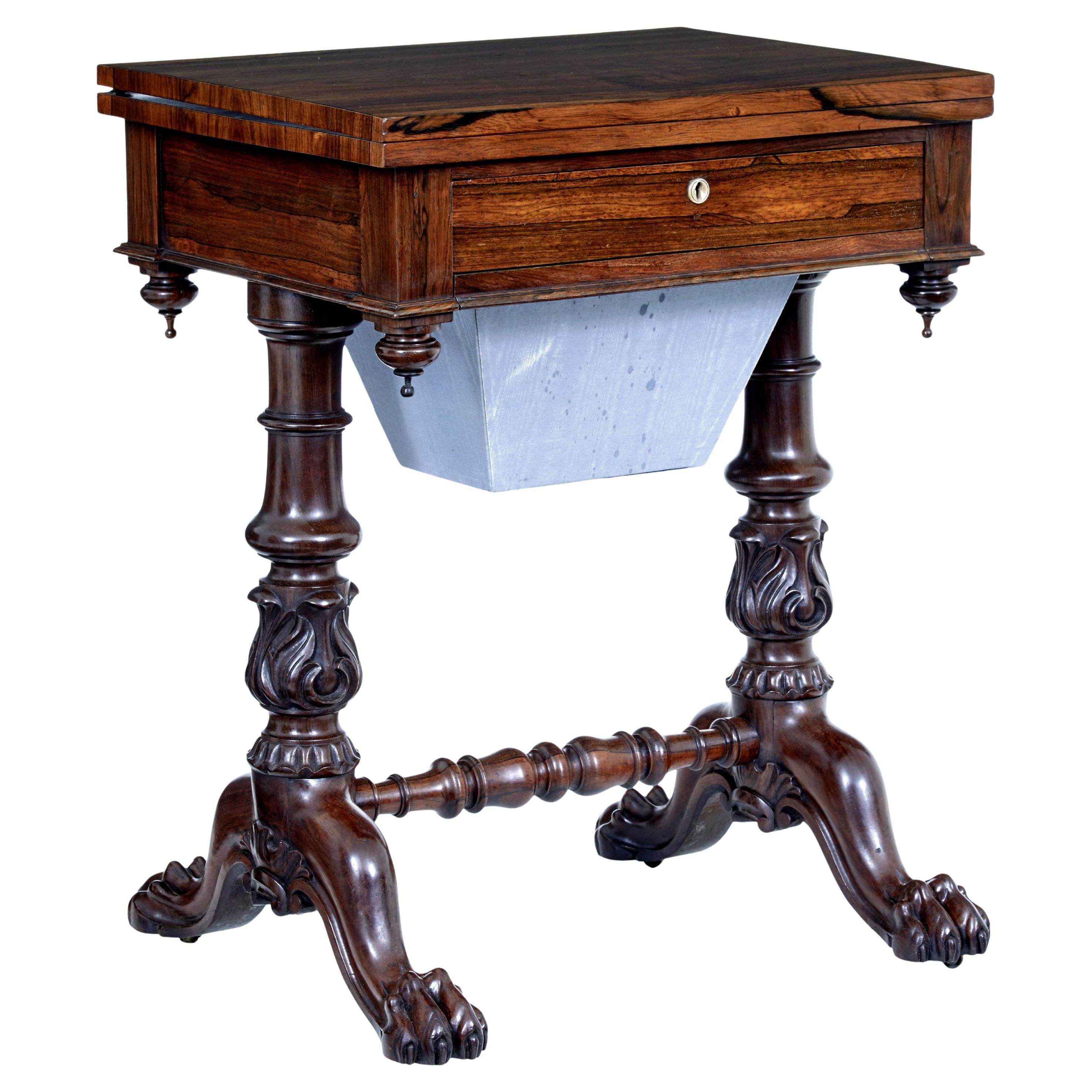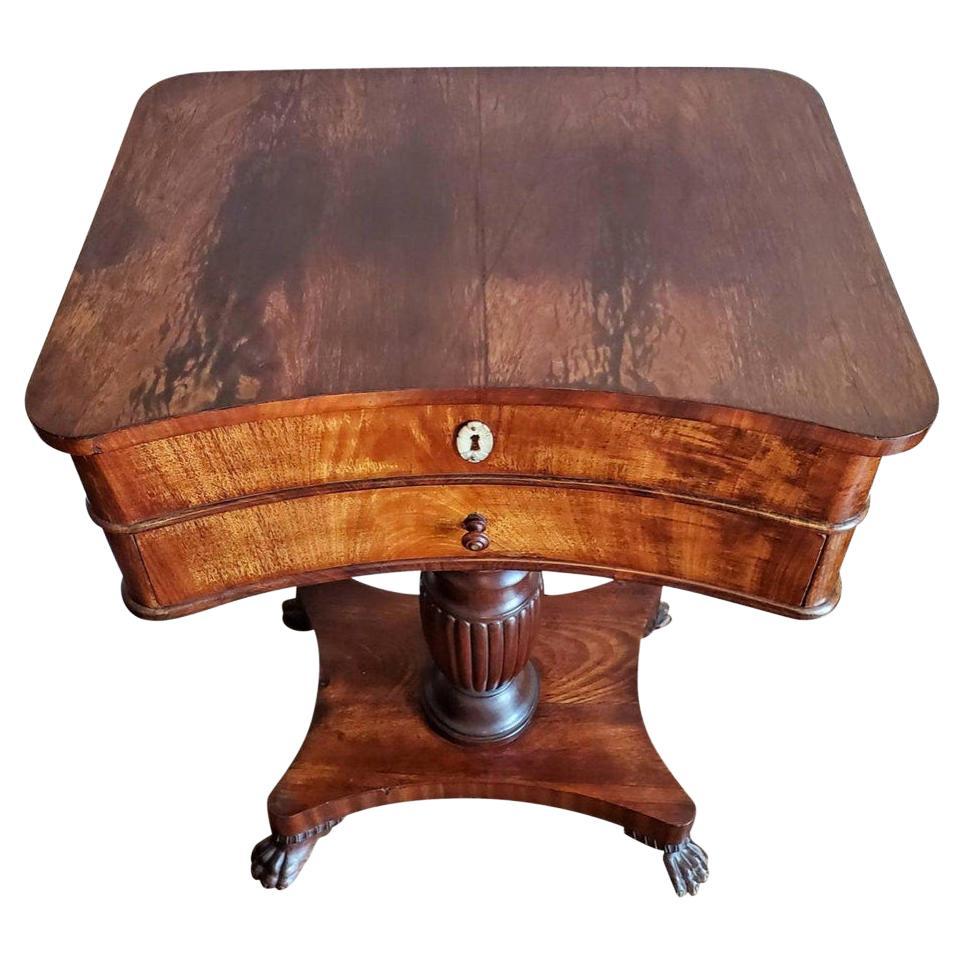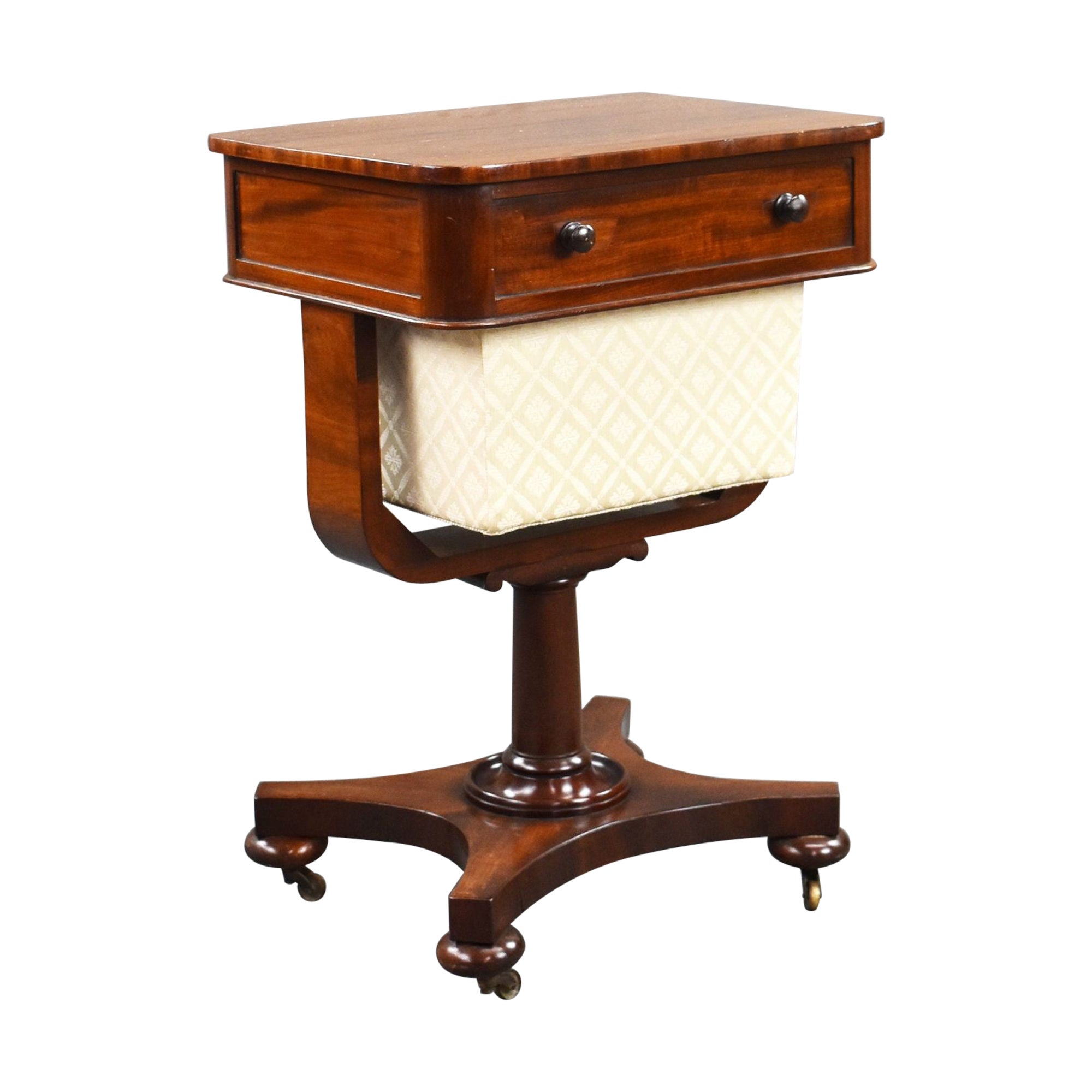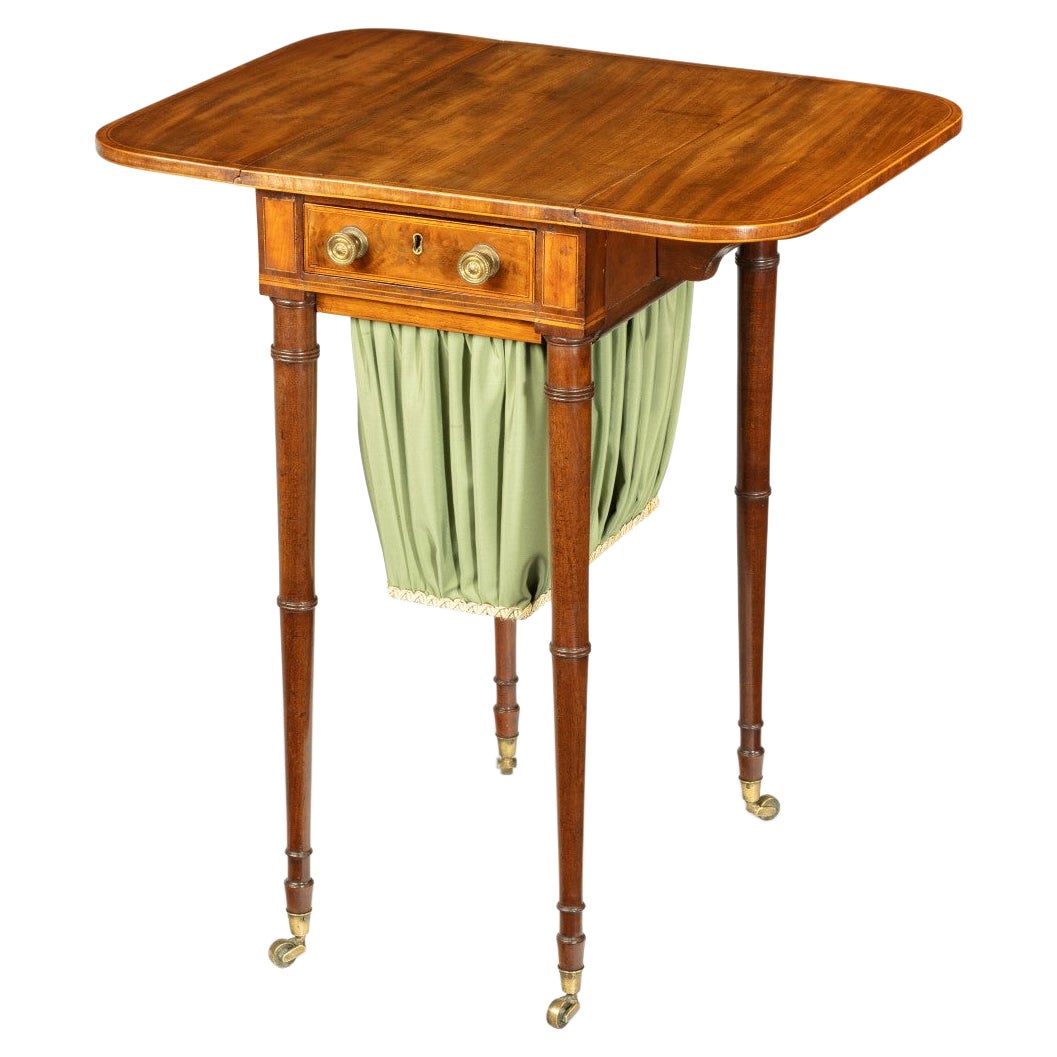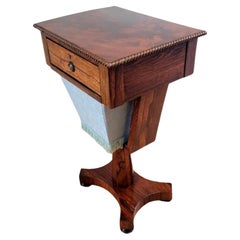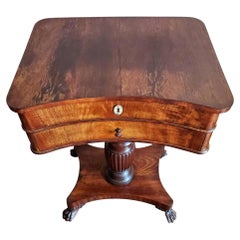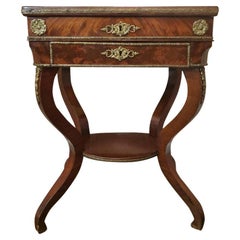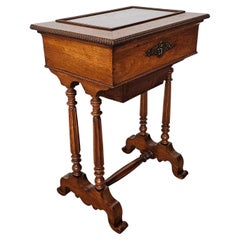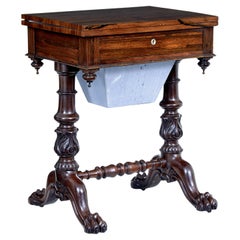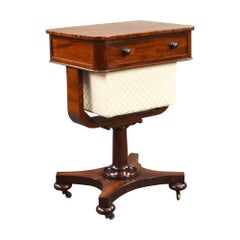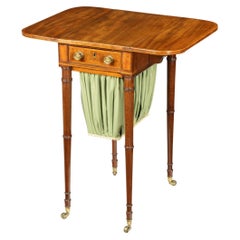Items Similar to William IV Period English Sewing Stand Work Table
Want more images or videos?
Request additional images or videos from the seller
1 of 21
William IV Period English Sewing Stand Work Table
$2,800
£2,119.17
€2,432.19
CA$3,988.83
A$4,325.98
CHF 2,272.17
MX$52,546.40
NOK 28,432.62
SEK 26,770.90
DKK 18,165.72
About the Item
A scarce nearly 200 year old English William IV Period rosewood and mahogany sewing stand work table with beautifully aged warm rustic patina. circa 1830s
Combining sophisticated elegance, warmth, classic simplicity, and functional design, this outstanding example was born in England in the mid-19th century, exquisitely hand-crafted of warm rich exotic rosewood, having a rectangular top with richly figured grain detail, over single frieze drawer with divided interior and quality hand-cut dovetail joinery, sliding spacious bin with the original blue fabric upholstered basket, flanked by decorative drop finials, rising on turned stretcher-joined trestle base, terminating on scroll feet.
DIMENSIONS: (approx)
29.5" High, 21" Wide, 15" Deep
VERSATILE:
As warm and handsome as it is useful, having the ideal size and proportions for a variety of different uses, including as a chair side table, sofa end table, occasional table, bedside nightstand, cocktail drinks server, diminutive hall console / pier table, petite parlor lamp stand, historic decorative accent piece, and more!
WILLIAM IV FURNITURE HISTORY:
It was unexpected that, at the age of 64, William IV was crowned king of England. He had two older brothers, yet the death of Prince Frederick put him in line for the British throne when George IV died in 1830. His reign was brief, as he died on June 20, 1837, but it was a pivotal time of change, with parliamentary reform leading to the present-day constitutional monarchy. Antique William IV–style furniture reflects this period of transition, with forms that bridged the neoclassicism of the preceding Regency style and the more extravagant Victorian style that would follow.
Inspired by ancient Greece and Rome, William IV designs were often more imposing than Regency furniture and featured decorative attributes. There were sofas balanced on lion’s feet and tables with brass fittings. But furnishings of this period were largely marked by straight lines and subdued ornamentation compared to those of the George IV era. William IV had an unassuming way about him and was much more formal, whereas the ruler who preceded him was a king of extravagance. George IV had an affinity for French decor and was heavily invested in overhauling the private residences at Windsor Castle.
Carvings on William IV four-poster beds and cabinets included scrolling shapes, lotus leaves and acanthus, while popular pieces like tilt-top tables and upholstered seating on caster legs provided flexible interiors. Richly toned woods like mahogany and rosewood were used for sideboards, bedposts boasting reeded details and dining chairs with intricate chair backs and turned front legs.
William IV left no legitimate heirs, so his young niece, Victoria, became queen. She would lead an era of taste in which the innovations of the Industrial Revolution allowed for manufacturing showier furniture to fill elaborate interiors. With its comparatively refined forms and restrained designs, William IV style was a pause before a time of radical aesthetic change.
PROVENANCE / ACQUISITION:
A private Highland Park estate collection of fine museum quality period antiques
Acquired from highly reputable auction house, J. Garrett Auctioneers, Dallas, Texas.
CONDITION:
Great condition with beautifully aged patina over the whole. Strong, sturdy, stable, structurally sound. Retaining original antique character and charm throughout, including scattered nicks, light scratches to top, fading or discoloration to original fabric basket cover, past restorations, all wear consistent with age and indicative of use, nothing that detracts from the aesthetics or functionality but only adds to the overall authenticity, elegant rustic warmth and rich historical depth that can only be acquired over very long periods of time.
Delivered cleaned, waxed, with hand rubbed polished French patina finish, ready for immediate use and generational enjoyment!
- Dimensions:Height: 29.5 in (74.93 cm)Width: 21 in (53.34 cm)Depth: 15 in (38.1 cm)
- Style:William IV (Of the Period)
- Materials and Techniques:
- Place of Origin:
- Period:
- Date of Manufacture:circa 1830s
- Condition:Wear consistent with age and use. Great condition w/beautifully aged patina. Sturdy, stable, structurally sound. Retaining original antique character/charm throughout, including scattered nicks, light scratches, fading to fabric. Wear consistent w/age & use. Cleaned, waxed, polished.
- Seller Location:Forney, TX
- Reference Number:1stDibs: LU5977234976942
About the Seller
4.8
Platinum Seller
Premium sellers with a 4.7+ rating and 24-hour response times
Established in 2013
1stDibs seller since 2021
298 sales on 1stDibs
Typical response time: <1 hour
- ShippingRetrieving quote...Shipping from: Forney, TX
- Return Policy
Authenticity Guarantee
In the unlikely event there’s an issue with an item’s authenticity, contact us within 1 year for a full refund. DetailsMoney-Back Guarantee
If your item is not as described, is damaged in transit, or does not arrive, contact us within 7 days for a full refund. Details24-Hour Cancellation
You have a 24-hour grace period in which to reconsider your purchase, with no questions asked.Vetted Professional Sellers
Our world-class sellers must adhere to strict standards for service and quality, maintaining the integrity of our listings.Price-Match Guarantee
If you find that a seller listed the same item for a lower price elsewhere, we’ll match it.Trusted Global Delivery
Our best-in-class carrier network provides specialized shipping options worldwide, including custom delivery.More From This Seller
View AllEarly 19th Century English Regency Period Sewing Table
Located in Forney, TX
An elegant Regency period English mahogany and rosewood work table, circa 1815, in the manner of Gillows, having an attractive flame mahogany top with rope trim detail, above a singl...
Category
Antique Early 19th Century Regency Side Tables
Materials
Fabric, Mahogany, Rosewood
Early 19th Century American Classical Sewing Stand
Located in Forney, TX
A fine and rare, beautifully restored American Classical period sewing stand work table in mahogany and rosewood.
Elegantly sophisticated, this scarce antique is a wonderful example of high quality early 19th century American craftsmanship. Exhibiting fine detail throughout, the exquisitely handcrafted work table features a hinged shaped top with rounded corners, curved concave front, stunning highly figured matched rosewood inlay complimented by mahogany cross banded edge, set over a conforming shaped case. Lifting the top opens to reveal a fitted interior divided into eight compartments, including a hinged lid with built-in flip-up pin cushion, various size shaped lids are finished in mahogany accented by contrasting satinwood string banded border, a faux drawer front with contrasting mother-of-pearl escutcheon rests above a single frieze drawer with hand carved dovetail joinery and original turned wooden pull. Below, a perfectly proportioned carved, turned and fluted solid mahogany central pedestal rises from a shaped platform base, in true Empire fashion, the base is further raised on ornately carved paw feet.
Beautiful, rich antique mahogany color...
Category
Antique Early 19th Century American Classical Industrial and Work Tables
Materials
Mother-of-Pearl, Mahogany, Rosewood, Satinwood
19th C. French Charles X Restoration Period Sewing Stand Work Table
Located in Forney, TX
A scarce period Charles X (1818-1834) French Restoration mahogany travailleuse sewing (thread stand - side table - jewelry dressing table) with light, warm, beautifully aged patina.
Born in France in the early 19th century, almost certainly Parisian work, exquisitely hand-crafted, this exceptionally executed example features ornate gilt bronze ormolu mounts, escutcheons, and elaborate gilt metal trim. Having a highly figured light mahogany hinged lid top, lifting open to reveal a striking finished interior with divided compartments and original inset mirror plate. The conforming rectangular case fitted with a faux drawer front over a dovetailed drawer with sectioned interior. Elegantly rising on oval-shaped medial shelf stretcher-joined curvacious legs.
Dimensions (approx):
27" High, 20" Wide, 13.5" Deep
Stunning light almost blonde antique mahogany coloring and mellow warm tone, superb wood grain detail, and charming, beautifully aged patina over the whole. Great shape overall. Retaining original antique character marks, wear consistent with age and indicative of minimal use, nothing that detracts from the aesthetics or functionality, but only adds to the overall authenticity, refined elegant warmth, luxurious sophistication, and cozy unpretentious rustic elegance.
Delivered cleaned, hand waxed, polished French patina finish, ready for immediate use and generational enjoyment!
What is Charles X style:
The comte d’Artois – or Charles X - was the son of the dauphin Louis-Ferdinand de Franc and Marie-Josèphe de Saxe. He succeeded his two brothers Louis XVI and Louis XVIII and became the King of France in 1824. Thirty years after the French Revolution, he wanted to embody the return of monarchy and became the leader of the catholic party . As the previous kings, he was crowned in 1825 but he was soon overthrown by the revolution in July, 1830, called "Trois Glorieuses". He left then for England, Scotland, Prague and Istria where he died in 1836.
Charles X style lasted from 1818 to 1834 and happened during the Bourbon Restoration (French Restoration). This style did not replace totally the style of furniture from the French Empire but it was different from the formalism in the Napoleonic era, during which strictness and simplicity were inspired by Greco-Roman art. Indeed, artistic fields flourished. In terms of furniture, this renewal was suggested by the softening of shapes. Even though the simple aspect from the French Empire was still visible, shapes became curvier with volutes and arabesques. Another distinction is the loss of the massive aspect of furniture and the decrease of dimensions in order to decorate smaller appartments. Handling ability and comfort were key-words in the making of furniture. Apartments had essential elements such as chests of drawers, big rounded tables in the dining room, desks or secretaries, armoires and even dressing tables, comfortable fainting couches in the living room, small tables, pedestal tables, as well as gondola chairs. The wavy aspect of the latters certainly represent Charles X style the best.
One of the most emblematic features of this style is the use of bois clairs – light woods in warm blond tones - and indigenous woods that are varnished in order to highlight the grains. Bird's-eye maple, ash trees, plane trees, yew trees, beech trees, olive trees and cedar trees were most likely to be used. Indeed, at the beginning of the 19th century dark woods were hard to find. In 1806, the Napoleon’s Continental System was established in order to ruin the United Kingdom by preventing the country from any business with the rest of Europe. Therefore craftsmen had to find alternatives from mahogany which was the most commonly used material at this time. After 1815, the import of wood was even more difficult because of peace treaties and the European political situation, which contributed to the popularity of the bois clairs and indigenous woods. The furniture was often decorated with fine inlays made out of dark wood representing foliage, which contrasted with the veneer. Even though these patterns can look like bronze decorations from the Empire era, they were far more simple and did not represent any military or mythological attributes. On the tables, trays were sometimes made out of marble as in the French Empire, but it was often put aside and inlaid veneer, Verre Eglomisé – a type of glass with a mirror finish –, mirror or porcelain from Sèvres or Paris were more likely to be used.
Decorative elements from the Monarchy were highly appreciated again as they suggested luxury. Indeed, marquetry work was particularly fashionable - Boulle marquetry thrived around 1820 as the works of the Levasseur family can show. In the same way, draperies and trimmings referred to the monarchist splendour. Fabrics were often white – the traditional colour of the Bourbons – or light coloured as oppposed to the typical green from the Napoleonic era.
One of the most symbolic figures from this period of time might be Jean-Jacques Werner (1791-1849), a cabinetmaker who worked for prestigious clients such as the Duchesse de Berry who was Charles’s step-daughter. His works can be seen at the Musée des Arts Décoratifs and at the Grand Trianon in the Palace of Versailles. The duchess’s appartments situated at the pavillon de Marsan and at the Palais de Saint Cloud illustrate Charles X style the best with furniture made out of bois clairs and ornamented with dark wood patterns or fine gold decorations.
Chales X style allows a transition between the sobriety of the Empire style and the abundant aspect of Louis-Philippe style. The gothic style started at this time through the "style à la cathédrale", inspired by religious architecture, which thrived from 1827 to 1830. Indeed, at the beginning of the 19th century, Romanticism put the spotlight on the Middle Ages. Cabinetmakers were not inspired by the medieval furniture but rather by architectural elements of churches and cathedrals. For instance the backs of chairs were decorated with arches shaped like rib and serration. In the same way, before Charles X abdicated, pieces of furniture were made out of dark woods – such as mahogany, which was used again in France – and were inlaid with light wood. Romanticism also influenced the layout of furniture in appartments to suggest movement through a mix of various styles, various shapes and various sizes, as opposed to the static aspect of Neoclassicism. The start of industrialisation and mechanisation also influenced this style as early technical developments led to the production of pieces of furniture in series.
Credit:
Marc Maison
Bibliography:
FANIEL Stéphane (Dir.), Le Dix-neuvième Siècle Français, Collection Connaissance des Arts, 1957, Hachette
SASSONE, Adriana Boidi, Furniture from Rococo to Art Deco, 2000, Evergreen
--
Extremely versatile:
As warm and attractive as it is useful, this remarkable antique table having the ideal size and small proportions for a variety of different uses, including as a side table, accent or occasional table, tall sofa...
Category
Antique Early 19th Century French Charles X End Tables
Materials
Bronze, Ormolu
Louis Philippe Period French Walnut Sewing Stand Work Table
Located in Forney, TX
A handsome nearly 200 year old French Louis Philippe period (1830-1848) walnut travailleuse (sewing work table - thread stand)
Born in France in the mid-19th century, hand-crafted o...
Category
Antique Mid-19th Century French Louis Philippe Industrial and Work Tables
Materials
Mirror, Walnut
Antique Slant-Front Drafting Desk Writing Table
Located in Forney, TX
A rare and exceptionally inlaid antique slant-front drafting desk. circa 1900
Hand-crafted in the early 20th century, likely French, one piece desk on frame form, having a sloped fr...
Category
Early 20th Century Louis XVI Desks and Writing Tables
Materials
Ebony, Kingwood, Mahogany, Maple, Palisander, Rosewood, Burl, Felt
Antique French Ledet et fils Louis XV Ladies Sewing Work Table Dressing Vanity
Located in Forney, TX
Refined country French elegance and sophistication at its finest, this Provincial Louis XV style lady's sewing stand work table or coiffeuse by Ledet et fils exudes refined grace and functionality.
Born in Bordeaux Region of Southwestern France in the mid-19th century, exceptionally executed in sophisticated King Louis Fifteenth (1715-1774) taste, hand-crafted of warm mellow solid mahogany, having a rectangular serpentine shaped hinged top opening to reveal the original flat mirror plate, over a removable divided tray, faux drawer front with wooden escutcheon, above a sewing / work bin, gently curved scalloped apron, all rising elegantly on long cabriole legs adorned with finely carved shell acanthus leaf knee ending in whorl feet, terminating on casters. circa 1850s
Signed, retaining the original ébéniste (cabinetmakers) makers mark to the underside, reading:
Ledet
Fab de Meubles
Bordeaux
Dimensions: (approx)
29.25" High, 24" Wide, 16.75" Deep
Versatile:
As warm and attractive as it is useful, having the ideal size and proportions for a variety of different uses, including as a side table, accent table, hall console, sofa table, bedside nightstand, rolling lamp...
Category
Antique Mid-19th Century French Louis XV Side Tables
Materials
Wood, Mahogany
You May Also Like
Fine Antique George IV Style Work Table With Divided Drawer
Located in Bridgeport, CT
A fine and likely English mahogany table with fine graining and excellent carving details. The top edge surrounded by a bold egg and dart surround, the trestle base with finely carve...
Category
Antique 19th Century English George IV Tables
Materials
Mahogany
William IV 19th century flip top side table
Located in Debenham, Suffolk
William iv 19th century palisander work table, circa 1830.
Made from stunning palisander with a rectangular top that rotates and flips open to form a bigger surface. Single silk lin...
Category
Antique Mid-19th Century English William IV Side Tables
Materials
Palisander
William IV Mahogany Work Table
Located in Chelmsford, Essex
For sale is a good quality William IV mahogany work table, having a single drawer over a basket, above the stem terminating on a platform base on bun feet, raised on castors. This pi...
Category
Antique 19th Century English Industrial and Work Tables
Materials
Mahogany
Elegant George III Mahogany Pembroke Sewing Table
Located in Lymington, Hampshire
An elegant George III mahogany Pembroke sewing table, of typical form with two shaped flaps on either side of a central drawer and pleated silk w...
Category
Antique Early 1800s English George III Drop-leaf and Pembroke Tables
Materials
Brass
William IV Writing Table
Located in Greenwich, CT
Fine William IV writing or side table of very clean architectural form, the well figured single board mahogany top over drawer and supported by trestle ends joined by turned stretche...
Category
Antique 1840s English William IV Desks and Writing Tables
Materials
Mahogany
$3,500
19th Century George III Period Reading Table
Located in Petworth,West Sussex, GB
A fine early 19th century George III period mahogany and ebony inlay reading table. The table features one faux drawer to one side and has a rise and fall reading slope. One side of ...
Category
Antique Early 19th Century British George III Tables
Materials
Brass
More Ways To Browse
Frederick Prince
Antique Four Poster King Size Bed
Charles Topino
Classicon Adjustable Table
Clip Corner Table
Column Side Table Pair
Copper Drum Table
Crescent Side Table
Crinkle Table
Curved Pencil Reed
Dance Of The Nymphs
Davis Furniture Company Side Table
Disc Side Table
Distressed Metal Side Table With Antique Finish
Drexel Cherry Table
Dupre Lafon Side Tables
Dux Cane
Elephant Leg Table
